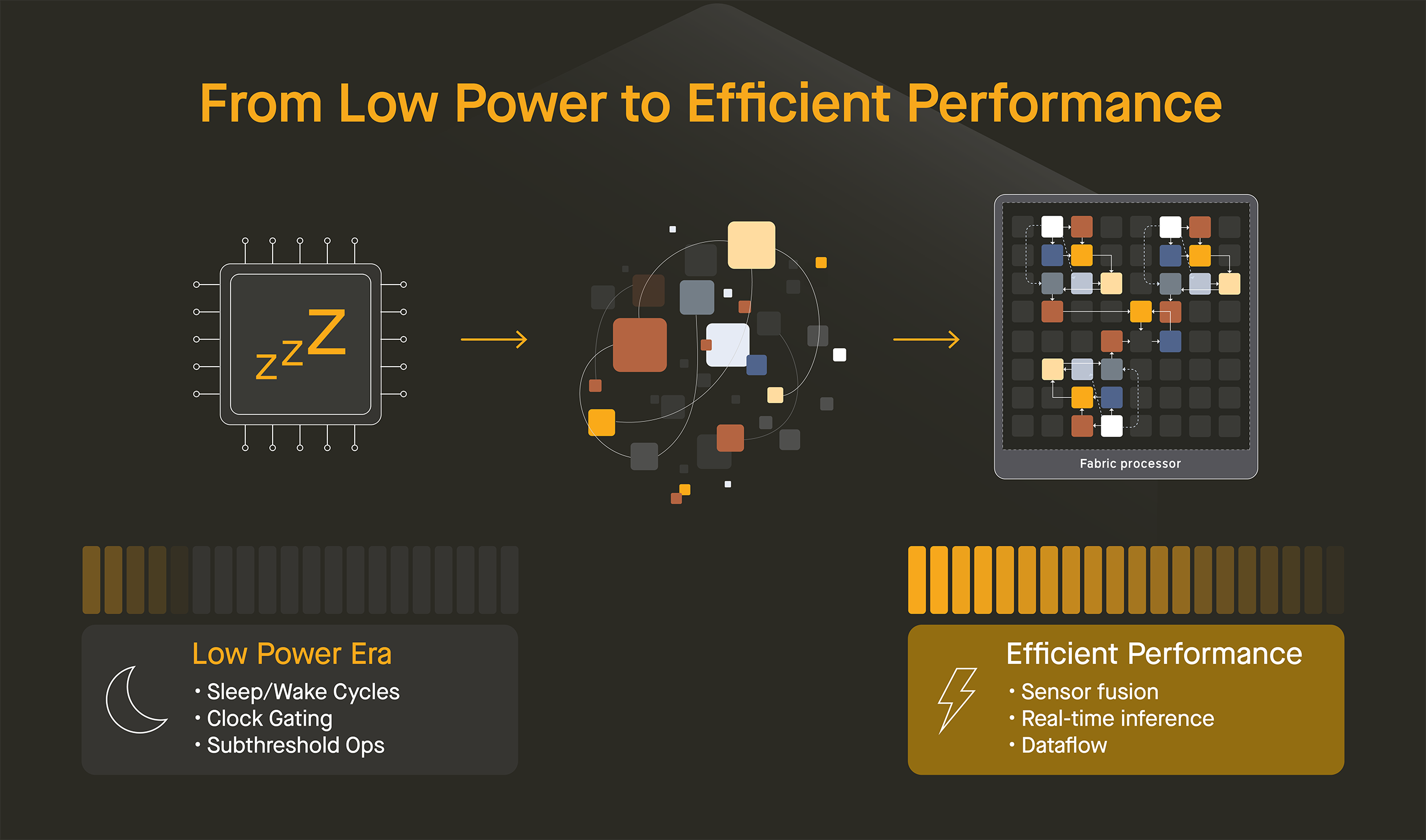Blog
Why “Low Power” Solved Yesterday’s Problems — and Efficient Performance Solves Tomorrow’s
By: Adam Kaufman, Director of Product Marketing

Why “Low Power” Solved Yesterday’s Problems — and Efficient Performance Solves Tomorrow’s
By: Adam Kaufman, Director of Product Marketing
For years, low power defined innovation. In wearables, smart home, and battery-powered devices, squeezing every microwatt determined who could ship, who could scale, and who could survive on a coin cell. That era produced important advances—subthreshold operation, aggressive clock gating, deep sleep states. Those techniques powered a generation of devices that mostly sensed, stored, or displayed.
But tomorrow’s edge devices don’t just sense—they think. They run continuous sensor fusion, real-time inference, and dynamic control loops. They require not just power savings, but sustained compute capability within the same energy envelope. “Low power” solved yesterday’s problem of idle energy waste. The problem now is active energy waste—and that demands something fundamentally new.
The Limits of “Low Power”
Traditional low-power design assumes long idle periods: the processor sleeps, wakes briefly, and goes back to rest. That assumption breaks when workloads are always on and always adaptive. The true measure of efficiency isn’t power draw alone—it’s useful work per joule.
A processor that burns less power but takes ten times longer to finish the same task isn’t efficient; it’s just slow. The future demands processors that deliver performance and efficiency at once—systems that minimize energy while running, not just while sleeping.
And yes—the Electron E1 delivers excellent sleep performance. The energy that defines modern workloads is in the active state, and that’s where the E1 outperforms everything else.

Efficiency Is the New Performance
The Electron E1 general-purpose processor redefines efficiency at its core. Built on Efficient’s Fabric spatial dataflow architecture, it executes programs as data flows through a network of compute tiles, eliminating instruction overhead, wasted cycles, and unnecessary memory movement.
The result is real, measurable efficiency:
- Orders of magnitude better energy efficiency than conventional architectures
- Up to 100× higher performance per watt for real-world workloads
- And single-digit-milliwatt-class active operation for continuous, intelligent edge tasks
Software plays an equally critical role. The effcc Compiler automatically maps programs onto the Fabric—extracting parallelism, optimizing data movement, and generating schedules that match the hardware’s structure. Developers write in familiar high-level languages, but the compiler transforms their code into dataflow execution graphs that achieve unmatched efficiency. It drops seamlessly into existing toolchains—your IDE stays the same; just swap compilers and keep coding in the languages you already know.
Tomorrow’s Benchmark: Joules per Insight
As computing moves out of the data center and into the physical world, energy efficiency becomes a measure of intelligence itself. The next decade won’t be about clock speeds or idle currents—it will be about how much insight you can deliver per joule consumed.
That’s what Efficient Computers is solving. Because “low power” made yesterday’s devices last longer—but efficient performance will make tomorrow’s devices smarter, faster, and sustainable.
.svg)

For years, low power defined innovation. In wearables, smart home, and battery-powered devices, squeezing every microwatt determined who could ship, who could scale, and who could survive on a coin cell. That era produced important advances—subthreshold operation, aggressive clock gating, deep sleep states. Those techniques powered a generation of devices that mostly sensed, stored, or displayed.
But tomorrow’s edge devices don’t just sense—they think. They run continuous sensor fusion, real-time inference, and dynamic control loops. They require not just power savings, but sustained compute capability within the same energy envelope. “Low power” solved yesterday’s problem of idle energy waste. The problem now is active energy waste—and that demands something fundamentally new.
The Limits of “Low Power”
Traditional low-power design assumes long idle periods: the processor sleeps, wakes briefly, and goes back to rest. That assumption breaks when workloads are always on and always adaptive. The true measure of efficiency isn’t power draw alone—it’s useful work per joule.
A processor that burns less power but takes ten times longer to finish the same task isn’t efficient; it’s just slow. The future demands processors that deliver performance and efficiency at once—systems that minimize energy while running, not just while sleeping.
And yes—the Electron E1 delivers excellent sleep performance. The energy that defines modern workloads is in the active state, and that’s where the E1 outperforms everything else.

Efficiency Is the New Performance
The Electron E1 general-purpose processor redefines efficiency at its core. Built on Efficient’s Fabric spatial dataflow architecture, it executes programs as data flows through a network of compute tiles, eliminating instruction overhead, wasted cycles, and unnecessary memory movement.
The result is real, measurable efficiency:
- Orders of magnitude better energy efficiency than conventional architectures
- Up to 100× higher performance per watt for real-world workloads
- And single-digit-milliwatt-class active operation for continuous, intelligent edge tasks
Software plays an equally critical role. The effcc Compiler automatically maps programs onto the Fabric—extracting parallelism, optimizing data movement, and generating schedules that match the hardware’s structure. Developers write in familiar high-level languages, but the compiler transforms their code into dataflow execution graphs that achieve unmatched efficiency. It drops seamlessly into existing toolchains—your IDE stays the same; just swap compilers and keep coding in the languages you already know.
Tomorrow’s Benchmark: Joules per Insight
As computing moves out of the data center and into the physical world, energy efficiency becomes a measure of intelligence itself. The next decade won’t be about clock speeds or idle currents—it will be about how much insight you can deliver per joule consumed.
That’s what Efficient Computers is solving. Because “low power” made yesterday’s devices last longer—but efficient performance will make tomorrow’s devices smarter, faster, and sustainable.
Stay in the loop
Be the first to know about our latest breakthroughs
Sign up to get updates on our advancements, industry insights, and expert opinions. Stay ahead with the future of energy-efficient computing.

.svg)
Stay up to date with our latest features and releases.

© 2025 Efficient Computer Company. All rights reserved.
